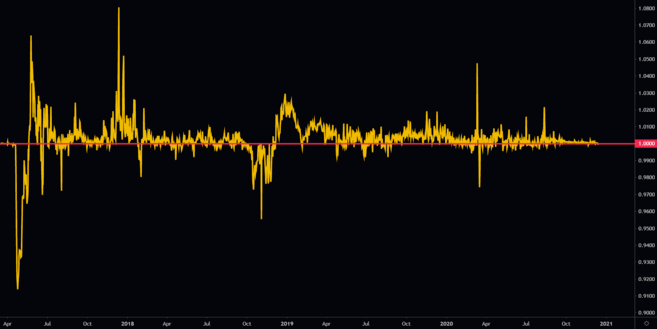TL;DR
Tether (USDT) is one of the most popular stablecoins out there. It was designed to hold a one-to-one value with the US dollar. The coin exists on many different blockchains and has experienced rising trading volumes and improved liquidity over the past few years.
Introduction
Tether is a key part of the cryptocurrency ecosystem. As of December 2020, Tether is ranked as the world’s fourth-largest cryptocurrency with a market cap of almost $20 billion, trailing only behind Bitcoin, Ethereum, and XRP. In addition, it often ranks as the coin with the highest daily trading volume, even surpassing Bitcoin.
But what is Tether, and how can it be useful to you?
What is Tether (USDT)?
Tether has gone on to experience both successes and controversies – much like many of the world’s foremost cryptocurrencies.
Especially in its early days, the price of USDT has been somewhat volatile, even reaching $1.2 at some point. The coin has experienced far less volatility since early 2019, however. This is likely thanks to a steady rise in its trading volume and the cryptocurrency markets’ overall advancement.
How does Tether (USDT) work?
Stablecoins’ utility is in their relative stability, as opposed to more traditional crypto assets. As a stablecoin, Tether’s appeal is in its tethering or pegging to fiat currency. USDT was said to have been originally pegged exactly to USD, with $1 USD held for every USDT in circulation.
Each tether unit issued into circulation is backed in a one-to-one ratio (i.e., one Tether USDT is one US dollar) by the corresponding fiat currency unit held in deposit by Hong Kong-based Tether Limited.
As you can see on the USDT/USD chart below, the coin (generally) trades at a stable one-to-one rate with USD. However, significant market events can have an effect on its price.
Why Tether (USDT) is important
Tether bridges the gap between crypto and fiat currencies. It presents an easy way for investors to obtain a one-to-one trade for the USD, without the innate volatility of other cryptocurrencies.
By providing this stability, investors can hold a digital asset similar to a fiat currency but with the ease of trading for other coins on the crypto markets. Tether’s key features make it a popular coin – although it isn’t immune to risks, either.
Key features
- 1:1 ratio (USD to USDT)
- Stability (as much as the USD can be considered stable)
- Available on different blockchains
- Different use cases as compared to traditional cryptocurrencies
Tether (USDT) use cases
Quick access to market stability
Easily move funds between exchanges
Trade on crypto-only exchanges
Some exchanges do not have facilities for fiat deposit and withdrawal but do allow USDT trading. By obtaining Tether first, you’re able to trade on these exchanges without worrying about the market volatility of placing your main trading funds in BTC (or other cryptos).
Forex-style trading
How to store Tether (USDT)
As USDT is issued on a range of different blockchains, you’ll need to ensure that you are transferring it from and to the same network.
USDT transfer network options on Binance.
So be careful. If you use the wrong network you might lose your funds. For instance, if you try to send Omni USDT to an ERC-20 USDT address, your transfer will most likely be lost.
Note that, as of December 2020, the ERC-20 USDT is the only type supported by Ledger. This means that the USDT running on the Bitcoin blockchain (Omni Layer) is not available to transfer to the Ledger hardware wallets.
Other Tether cryptocurrencies
Apart from USDT, Tether also has other stablecoins:
- EURT: a Euro-pegged Tether coin
- CNHT: a Chinese Yuan-pegged Tether coin
- XAUT: a physical gold-pegged Tether coin
Closing thoughts
Stablecoins introduced a lot of convenience in the crypto trading world as they reduce the need for traders to convert several times between fiat currencies and crypto. As such, USDT is a handy asset to have on hand for crypto trading.
While there have been various questions about the validity of the reserves, volumes over the past few years indicate faith in Tether's value as a stablecoin. Apart from USDT, you can also opt to use other stablecoins, such as BUSD, USDC, TUSD and PAX.


